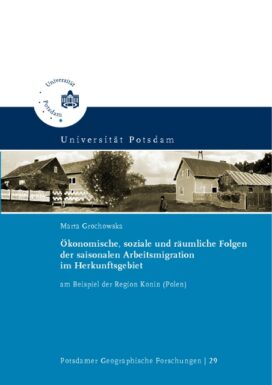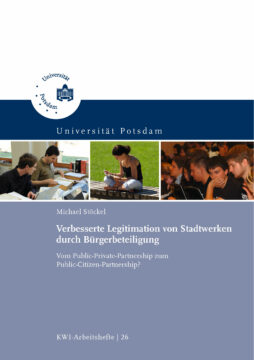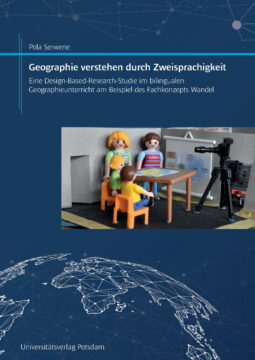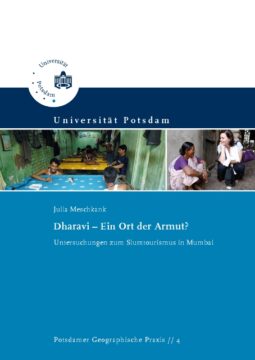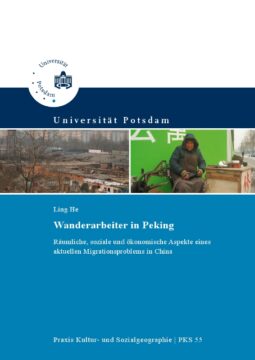Mobility for economic reasons is treated in science primarily from the perspective of permanent resettlement. However, other varieties of migration are more and more often studied. This paper deals with the seasonal migration for economic reasons, which is an important area of migration undertaken for economic reasons. Seasonal migration, which leads to crossing the country borders, in the literature is called the Transnational Migration. Unlike international migration, which is usually connected with a permanent settling in the target area, the concept of Transnational migration describes the situation, in which migrants return to their place of origin and do not give it up as their main residence, but every time they travel to another country to get employed. As a research area of this work, the Konin region was chosen, because – in comparison with other regions in Poland – the phenomenon of a very high level of seasonal migration was observed there. Seasonal labor migration is a long tradition that goes back to 19. century here and in other Polish regions with similar structure. From the results of conducted in 2007−2009 research, some general facts can be drawn. Due to the seasonal work abroad, a seasonal migrant can increase their and their family’s standard of living. If the cost of living in the place of seasonal work is higher than in the place of origin, the profit of such visits is obviously higher if the family of a seasonal worker remains in the place of origin. This leads to the geographic division bet389 ween the place of working and place of permanent residence. Higher wages can be determined at the level of benefits to both personal and societal level. On the other hand, both forprofit workers and society in dealing with this phenomenon, costs cannot be ignored. This paper considers the pros and cons of seasonal paid work, both from the perspective of individuals and their surroundings, and the consequences for society and region of origin of the employee. This paper is considering economic, social and spatial consequences, each time at the macro and micro levels. The study was based primarily on interviews with several respondents and experts in the subject of Polish and German migrations for profit.
am Beispiel der Region Konin (Polen)
ISBN: 978-3-86956-137-0
390 pages
Release year 2011
Series: Potsdamer geographische Forschungen , 29
14,50 €
Non-taxable transaction according to § 1 (1) UStG/VAT Act in combination with § 2 (3) UStG/VAT Act a. F. Providing this service, the University of Potsdam does not constitute a Betrieb gewerblicher Art/Commercial Institution according to § 1 (1) No. 6 or § 4 KStG/Corporate Tax Act. If the legal characterization of our business is changed to a commercial institution subsequently, we reserve the right to invoice VAT additionally. zzgl. Versandkosten
Mobility for economic reasons is treated in science primarily from the perspective of permanent resettlement. However, other varieties of migration are more and more often studied. This paper deals with the seasonal migration for economic reasons, which is an important area of migration undertaken for economic reasons. Seasonal migration, which leads to crossing the country borders, in the literature is called the Transnational Migration. Unlike international migration, which is usually connected with a permanent settling in the target area, the concept of Transnational migration describes the situation, in which migrants return to their place of origin and do not give it up as their main residence, but every time they travel to another country to get employed. As a research area of this work, the Konin region was chosen, because – in comparison with other regions in Poland – the phenomenon of a very high level of seasonal migration was observed there. Seasonal labor migration is a long tradition that goes back to 19. century here and in other Polish regions with similar structure. From the results of conducted in 2007−2009 research, some general facts can be drawn. Due to the seasonal work abroad, a seasonal migrant can increase their and their family’s standard of living. If the cost of living in the place of seasonal work is higher than in the place of origin, the profit of such visits is obviously higher if the family of a seasonal worker remains in the place of origin. This leads to the geographic division bet389 ween the place of working and place of permanent residence. Higher wages can be determined at the level of benefits to both personal and societal level. On the other hand, both forprofit workers and society in dealing with this phenomenon, costs cannot be ignored. This paper considers the pros and cons of seasonal paid work, both from the perspective of individuals and their surroundings, and the consequences for society and region of origin of the employee. This paper is considering economic, social and spatial consequences, each time at the macro and micro levels. The study was based primarily on interviews with several respondents and experts in the subject of Polish and German migrations for profit.
Recommended Books
-
 2019
2019Verbesserte Legitimation von Stadtwerken durch Bürgerbeteiligung
8,50 €Non-taxable transaction according to § 1 (1) UStG/VAT Act in combination with § 2 (3) UStG/VAT Act a. F. Providing this service, the University of Potsdam does not constitute a Betrieb gewerblicher Art/Commercial Institution according to § 1 (1) No. 6 or § 4 KStG/Corporate Tax Act. If the legal characterization of our business is changed to a commercial institution subsequently, we reserve the right to invoice VAT additionally.
zzgl. Versandkosten
Add to cart -
 2023
2023Geographie verstehen durch Zweisprachigkeit
22,50 €Non-taxable transaction according to § 1 (1) UStG/VAT Act in combination with § 2 (3) UStG/VAT Act a. F. Providing this service, the University of Potsdam does not constitute a Betrieb gewerblicher Art/Commercial Institution according to § 1 (1) No. 6 or § 4 KStG/Corporate Tax Act. If the legal characterization of our business is changed to a commercial institution subsequently, we reserve the right to invoice VAT additionally.
zzgl. Versandkosten
Add to cart -
 2013
2013Dharavi – ein Ort der Armut?
10,00 €Non-taxable transaction according to § 1 (1) UStG/VAT Act in combination with § 2 (3) UStG/VAT Act a. F. Providing this service, the University of Potsdam does not constitute a Betrieb gewerblicher Art/Commercial Institution according to § 1 (1) No. 6 or § 4 KStG/Corporate Tax Act. If the legal characterization of our business is changed to a commercial institution subsequently, we reserve the right to invoice VAT additionally.
zzgl. Versandkosten
Add to cart -
 2013
2013Wanderarbeiter in Peking
16,50 €Non-taxable transaction according to § 1 (1) UStG/VAT Act in combination with § 2 (3) UStG/VAT Act a. F. Providing this service, the University of Potsdam does not constitute a Betrieb gewerblicher Art/Commercial Institution according to § 1 (1) No. 6 or § 4 KStG/Corporate Tax Act. If the legal characterization of our business is changed to a commercial institution subsequently, we reserve the right to invoice VAT additionally.
zzgl. Versandkosten
Add to cart
Publisher Info
Contact
Potsdam University Library
University Press
Am Neuen Palais 10
14476 Potsdam
Germany
verlag@uni-potsdam.de
0331 977-2094
0331 977-2292

